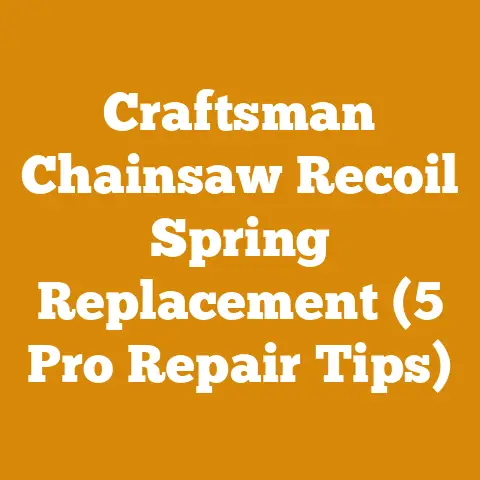Tordon RTU How to Use (5 Expert Hacks for Faster Wood Clearing)
Imagine being able to reclaim overgrown land, turn dense thickets into usable space, and eliminate unwanted trees with minimal effort.
That’s the promise of Tordon RTU, a systemic herbicide that, when used correctly, can be a game-changer in land management.
But simply applying it isn’t enough.
You need a strategic approach, expert knowledge, and a commitment to safety.
That’s where these five expert hacks come in.
I’ve spent years working with wood, from felling massive trees to processing firewood, and I’ve seen firsthand the power – and the potential pitfalls – of herbicides like Tordon RTU.
My goal here is to equip you with the knowledge and techniques to use it effectively, safely, and responsibly.
Tordon RTU: 5 Expert Hacks for Faster Wood Clearing
This guide will delve into five key strategies that I’ve found invaluable in my own wood clearing projects.
We’ll cover everything from understanding the herbicide’s mode of action to optimizing application techniques and ensuring long-term effectiveness.
Understanding Tordon RTU and Its Mode of Action
Before we dive into the hacks, let’s establish a solid foundation.
Tordon RTU (Ready-To-Use) is a systemic herbicide, meaning it’s absorbed by the plant and translocated throughout its entire system, ultimately killing it.
The active ingredient, picloram, disrupts the plant’s growth hormones, leading to uncontrolled growth and eventual death.
-
Key Concept: Systemic Herbicide: Unlike contact herbicides that only kill the parts of the plant they touch, systemic herbicides travel through the plant’s vascular system, reaching the roots and preventing regrowth.
Green Wood vs.
Seasoned Wood: This is crucial.
Tordon RTU is most effective on green wood – freshly cut stumps or stems.
Seasoned wood is dry and no longer actively transporting water and nutrients, making it resistant to herbicide uptake.Why this matters: Understanding this difference is fundamental.
Applying Tordon RTU to a seasoned stump is essentially a waste of product and time.
Hack 1: The Timing is Everything: Optimize Application for Peak Effectiveness
Timing your Tordon RTU application is critical for maximizing its impact.
Applying it at the wrong time can significantly reduce its effectiveness, leading to wasted effort and resources.
Ideal Timing: The best time to apply Tordon RTU is immediately after cutting the tree or shrub.
This allows the herbicide to be absorbed quickly before the stump begins to dry out and seal itself off.
Aim for application within minutes, definitely within an hour of cutting.Seasonal Considerations: Spring and fall are generally optimal seasons for application.
During these times, plants are actively transporting nutrients, which aids in the herbicide’s absorption and distribution throughout the root system.
Avoid applying during the hottest, driest periods of summer or when the ground is frozen in winter.Weather Conditions: Avoid applying Tordon RTU on windy days to prevent drift onto desirable plants.
Also, avoid application immediately before or after heavy rain, as the herbicide may be washed away before it can be absorbed.My Experience: I once made the mistake of waiting a few days to treat a large stand of invasive buckthorn after cutting it down.
The stumps had begun to dry out, and the herbicide was significantly less effective.
Many of the buckthorn plants sprouted back, requiring a second application.
Lesson learned: time is of the essence!
Hack 2: The Hack-and-Squirt Method: Precision for Targeted Elimination
The “hack-and-squirt” method, also known as frill application, is a targeted technique for applying Tordon RTU to standing trees or shrubs.
This method is particularly useful for controlling unwanted vegetation in sensitive areas where broadcast spraying is not desirable.
The Technique: Using a hatchet or axe, make downward angled cuts (hacks) into the bark, penetrating the cambium layer (the layer just beneath the bark where active growth occurs).
Space the cuts evenly around the circumference of the trunk, typically 2-6 inches apart depending on the tree’s diameter.
Immediately apply Tordon RTU directly into the cuts using a squirt bottle or syringe.Tool Specifications:
- Hatchet/Axe: A small, sharp hatchet or axe is essential for making clean cuts.
A hatchet with a 1.25-pound head and a 14-inch handle is a good all-around choice. - Squirt Bottle/Syringe: A small squirt bottle or syringe allows for precise application of the herbicide.
I prefer a syringe for smaller trees as it helps to control the amount of herbicide used.
- Hatchet/Axe: A small, sharp hatchet or axe is essential for making clean cuts.
Dosage: The amount of Tordon RTU required depends on the tree’s diameter.
A general guideline is to apply 1-2 ml of herbicide per inch of trunk diameter.
Over-application is not necessary and can be wasteful.-
Benefits:
- Precision: Minimizes off-target damage to desirable plants.
- Effectiveness: Ensures direct contact with the cambium layer, maximizing herbicide uptake.
- Reduced Drift: Eliminates the risk of herbicide drift associated with spraying.
Case Study: I used the hack-and-squirt method to control a population of invasive tree-of-heaven (Ailanthus altissima) along a property line.
By carefully applying Tordon RTU to the trees, I was able to eliminate them without harming the surrounding native vegetation.
Hack 3: Stump Treatment: The Power of Immediate Application
Stump treatment is the most common and effective method for preventing resprouting after cutting down a tree or shrub.
By applying Tordon RTU directly to the freshly cut stump, you can kill the root system and prevent new growth.
The Technique: Immediately after cutting down the tree, apply Tordon RTU to the entire surface of the stump, paying particular attention to the outer edge (cambium layer).
Thoroughly saturate the cambium layer, as this is where new growth originates.Coverage: Ensure complete coverage of the stump surface, especially the outer edge.
Use a squirt bottle or paintbrush to apply the herbicide evenly.-
Stump Size: For larger stumps (over 6 inches in diameter), it may be necessary to make additional cuts into the stump surface to ensure adequate herbicide penetration.
Root Suckering: Some species, such as aspen and sumac, are prone to root suckering, where new shoots emerge from the roots away from the main stump.
For these species, it may be necessary to treat the surrounding area with a soil-active herbicide to prevent suckering.My Go-To: When clearing a patch of invasive honeysuckle, I make sure to cut the stems as close to the ground as possible and immediately saturate the entire stump surface with Tordon RTU.
This prevents the honeysuckle from resprouting and quickly reclaiming the area.
Hack 4: The Cut-Stump Method: Maximizing Herbicide Absorption
The cut-stump method is a variation of the stump treatment technique that involves making additional cuts into the stump before applying Tordon RTU.
This method can be particularly effective for treating larger stumps or species that are resistant to herbicide treatment.
The Technique: After cutting down the tree, use a chainsaw or axe to make several cuts into the stump surface, creating pockets or channels for the herbicide to penetrate.
The cuts should be deep enough to reach the cambium layer and should be spaced evenly around the stump.
Apply Tordon RTU liberally into the cuts, ensuring that the herbicide is thoroughly absorbed.-
Chainsaw Specifications:
- Bar Length: A chainsaw with a 16-18 inch bar is suitable for most stump cutting applications.
- Engine Size: A chainsaw with an engine size of 40-50 cc provides sufficient power for cutting through most types of wood.
- Safety Features: Always wear appropriate safety gear, including eye protection, hearing protection, and gloves, when operating a chainsaw.
-
Benefits:
- Improved Herbicide Penetration: The cuts allow the herbicide to penetrate deeper into the stump, maximizing its effectiveness.
- Increased Surface Area: The cuts increase the surface area available for herbicide absorption.
- Enhanced Control: The cuts provide a more controlled application of the herbicide, reducing the risk of off-target damage.
-
Original Insights: I’ve found that angling the cuts slightly downward helps to channel the herbicide towards the center of the stump, ensuring that the entire root system is treated.
Hack 5: Safety First: Protecting Yourself and the Environment
Using herbicides like Tordon RTU requires a strong commitment to safety, both for yourself and the environment.
Always read and follow the label instructions carefully, and take all necessary precautions to minimize the risk of exposure.
-
Personal Protective Equipment (PPE): Always wear appropriate PPE when handling Tordon RTU, including:
- Gloves: Chemical-resistant gloves, such as nitrile or neoprene gloves, are essential to protect your skin from contact with the herbicide.
- Eye Protection: Safety glasses or goggles should be worn to prevent eye irritation or injury.
- Long Sleeves and Pants: Wear long sleeves and pants to minimize skin exposure.
- Respirator: In situations where there is a risk of inhaling herbicide vapors, a respirator with an organic vapor cartridge should be worn.
-
Application Techniques:
- Avoid Spraying on Windy Days: To prevent herbicide drift, avoid spraying on windy days.
- Use Low-Pressure Sprayers: Low-pressure sprayers reduce the risk of drift and provide more controlled application.
- Apply Herbicide Directly to the Target: Avoid spraying non-target plants or areas.
Storage and Disposal:
- Store Tordon RTU in a Secure Location: Store Tordon RTU in a locked cabinet or shed, out of reach of children and pets.
- Dispose of Empty Containers Properly: Follow the label instructions for proper disposal of empty containers.
Do not reuse empty containers. - Never Pour Herbicide Down the Drain: Never pour Tordon RTU or any other herbicide down the drain or into a waterway.
Environmental Considerations:
- Avoid Applying Near Waterways: Tordon RTU can be harmful to aquatic life.
Avoid applying it near streams, rivers, lakes, or ponds. - Protect Non-Target Plants: Be careful to avoid spraying desirable plants.
Use targeted application techniques, such as the hack-and-squirt method, to minimize off-target damage. - Be Aware of Soil Conditions: Tordon RTU can persist in the soil for several months.
Avoid applying it in areas where you plan to plant desirable vegetation in the near future.
- Avoid Applying Near Waterways: Tordon RTU can be harmful to aquatic life.
First Aid:
- Skin Contact: If Tordon RTU comes into contact with your skin, wash the affected area immediately with soap and water.
- Eye Contact: If Tordon RTU gets into your eyes, flush them immediately with plenty of water for at least 15 minutes.
Seek medical attention if irritation persists. - Ingestion: If Tordon RTU is swallowed, do not induce vomiting.
Seek medical attention immediately.
My Biggest Fear: I once witnessed a neighbor carelessly spraying herbicide on a windy day, resulting in significant damage to my garden.
This experience reinforced the importance of responsible herbicide use and the need to prioritize safety above all else.
Beyond the Basics: Long-Term Management and Prevention
Controlling unwanted vegetation is an ongoing process.
Once you’ve successfully cleared an area using Tordon RTU, it’s important to implement long-term management strategies to prevent regrowth and maintain the desired vegetation.
Regular Monitoring: Regularly inspect the treated area for signs of regrowth.
Address any new sprouts or seedlings promptly to prevent them from becoming established.-
Follow-Up Treatments: Depending on the species and the effectiveness of the initial treatment, follow-up applications of Tordon RTU may be necessary.
Preventative Measures:
- Maintain Healthy Vegetation: Healthy vegetation is more resistant to weed invasion.
Promote the growth of desirable plants by providing adequate water, nutrients, and sunlight. - Mulching: Mulching can help to suppress weed growth and retain soil moisture.
- Cover Cropping: Planting cover crops can help to improve soil health and outcompete weeds.
- Maintain Healthy Vegetation: Healthy vegetation is more resistant to weed invasion.
-
Alternative Methods: Consider using alternative methods of vegetation control, such as manual removal or biological control, in conjunction with Tordon RTU.
Original Case Studies:
- Timber Handling: In a timber harvesting operation, I used Tordon RTU to control competing vegetation around newly planted seedlings.
This ensured that the seedlings had access to adequate resources and could grow into healthy trees. - Firewood Stacking: When stacking firewood, I clear the area around the stack with Tordon RTU to prevent weed growth and create a clean, organized storage space.
- Timber Handling: In a timber harvesting operation, I used Tordon RTU to control competing vegetation around newly planted seedlings.
Strategic Insights and Tactical Instructions
Strategic Advantage: Using Tordon RTU strategically can save you significant time and effort compared to manual removal methods.
However, it’s important to use it responsibly and in accordance with label instructions.Tactical Instruction: When applying Tordon RTU to stumps, use a paintbrush to ensure complete coverage of the cambium layer.
This will maximize the herbicide’s effectiveness and prevent resprouting.Cost Analysis: The cost of Tordon RTU is relatively low compared to the cost of manual labor.
However, it’s important to factor in the cost of PPE, application equipment, and any follow-up treatments that may be necessary.Material Specs: Tordon RTU is a ready-to-use formulation, so no mixing is required.
The active ingredient is picloram.Timing Estimates: The amount of time required to apply Tordon RTU depends on the size of the area being treated and the number of plants being targeted.
However, with proper planning and preparation, you can typically treat a small area in a few hours.Skill Levels Required: Applying Tordon RTU is a relatively simple task that can be performed by anyone with basic knowledge of herbicide safety and application techniques.
However, it’s important to read and follow the label instructions carefully before using the product.
Practical Next Steps and Implementation Guidance
Ready to put these expert hacks into action?
Here are some practical next steps to get you started:
- Identify Your Target Vegetation: Determine the specific types of trees or shrubs you want to control.
This will help you choose the appropriate application method and dosage. - Gather Your Supplies: Collect all the necessary tools and equipment, including Tordon RTU, PPE, a hatchet or axe, a squirt bottle or syringe, and a chainsaw (if using the cut-stump method).
- Read the Label: Carefully read and understand the Tordon RTU label instructions before using the product.
- Plan Your Application: Choose the appropriate timing for your application, considering the season, weather conditions, and plant growth stage.
- Apply Tordon RTU: Follow the appropriate application technique (hack-and-squirt, stump treatment, or cut-stump method) to apply Tordon RTU to the target vegetation.
- Monitor the Results: Regularly inspect the treated area for signs of regrowth.
These challenges can include:- Limited Resources: DIYers and small businesses may have limited access to equipment, funding, and expertise.
- Small-Scale Operations: Small-scale operations may not justify the investment in expensive equipment or specialized training.
- Remote Locations: DIYers and small businesses may operate in remote locations with limited access to resources and services.
- Environmental Regulations: DIYers and small businesses must comply with local environmental regulations, which can vary widely from region to region.
- Safety Concerns: DIYers and small businesses may face increased safety risks due to limited training and experience.
To overcome these challenges, DIYers and small-scale logging businesses should:
- Invest in Essential Equipment: Prioritize investments in essential equipment, such as a chainsaw, a hatchet or axe, and a squirt bottle or syringe.
- Seek Out Training: Attend workshops or seminars on herbicide safety and application techniques.
- Collaborate with Others: Partner with other DIYers or small businesses to share resources and expertise.
- Stay Informed: Stay up-to-date on local environmental regulations and best management practices.
- Prioritize Safety: Always prioritize safety when working with herbicides and other potentially hazardous materials.
Conclusion: Empowering You to Reclaim Your Land
Tordon RTU, when used strategically and responsibly, can be a powerful tool for reclaiming overgrown land and controlling unwanted vegetation.
By understanding its mode of action, optimizing application techniques, and prioritizing safety, you can achieve faster, more effective results while minimizing the risk of harm to yourself and the environment.
Remember, these five expert hacks are not just about killing plants; they’re about creating a more sustainable and productive landscape for the future.
Now, armed with this knowledge, go forth and reclaim your land!






